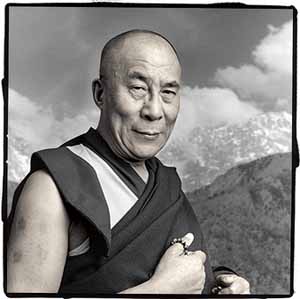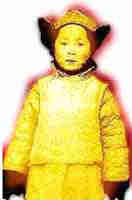
The XIV Dalai Lama of Tibet: Photo by: Phil Borges / www.philborges.com
In 1937, a two-year-old Tibetan boy was taken from his parents in the north-eastern reaches of his country to the capital, Lhasa. Tenzin Gyatso earned his first trip to the capital because he was recognised as the reincarnation of His Holiness the Thirteenth Dalai Lama, the supreme spiritual and temporal leader of Tibet.
The Fourteenth Dalai Lama was educated primarily in the Gelugpa school of Tibetan Buddhism and received the Geshe Lharampa, the highest degree awarded by the school. He was also extensively tutored by revered lamas of the Kagyu, Sakya, and Nyingma traditions. As head of state, the Fourteenth Dalai Lama attempted to negotiate with Chinese leaders like Mao Tse-Tung. The purpose was to save his country from the excesses of the Peoples Liberation Army (PLA), which crushed an uprising by the Tibetan people in Lhasa in March 1959, and forced the Dalai Lama into exile along with over 80,000 followers. They were granted asylum by the Indian government, and the Dalai Lama has headed the Tibetan Government-in-Exile ever since at the Himalayan village of Dharamshala. Apart from his religious discourses with leading practitioners from traditions like Christianity, Judaism, and Hinduism, Tenzin Gyatso's long-standing interest in science and technology leads him to discussions with scientists from around the world on topics ranging from cognitive neurology to physics. Applying Buddhist principles to the political crises that have plagued his country for half a century now, the Fourteenth Dalai Lama proposed a Five-point Peace Plan in 1987 in an address to the US Congress. According to his plan, Tibet is to become a de-militarised zone of peace, the Tibetan people would be allowed to practice their religion freely, and negotiations would be held between the Chinese government and the Tibetan government-in-exile. The plan was quickly shot down by Beijing, leading to demonstrations in Lhasa and another crackdown by PLA. But despite the harshness of the Chinese rule in Tibet, the Dalai Lama continues to insist on the need for a non-violent solution; indeed, he constantly proclaims that the proper response toward the Chinese government is not one of anger or hatred, but of heartfelt compassion and love. His unswerving dedication to the cause of his people through peaceful means earned him the Nobel Peace Prize in 1989. 
The Dalai Lama escorted by Tibetan resistance fighters --
|
